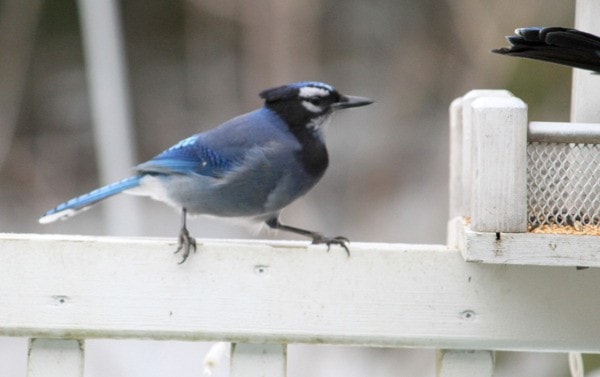It is not often that a bird shows up that is so distinctly two birds put together in one. It happened in early December at a bird feeder near Boswell. It seemed to be a definite cross or hybrid of a Steller’s jay (Cyanocitta stelleri), B.C.’s provincial bird, and a blue jay (Cyanocitta crestata), more common east of the Rockies. These are two distinct species, at least according to taxonomists. What would you think if you saw a Steller’s jay at the bird feeder that had a blue jay face, white throat, white rump and a blue jay tail? I have never heard of the like much less seen such a bird.
Among others of the animal kingdom, like mules, which are a cross between an ass and a horse, hybrids are usually sterile. Two hybrids do not produce offspring. That helps in the definition of a species. I guess if jay hybrids can produce young, then the initial parents are not different species but races of the same species. Does that make sense? After looking at over a dozen photos, I concluded that the jay in question looked pretty normal, but who knows? This jay cross appeared to be intimidated by the accompanying Steller’s jays, staying out of the feeder when Steller’s jays were in it. However, it hoisted its Steller’s jay-like crest in usual Steller’s jay fashion when it was in the feeder by itself. Otherwise, when around the other Steller’s jays, the crest was down.
Actually, I have observed most blue jay’s crests to be laid back when foraging with Steller’s jays and when by themselves out of their usual breeding territory and out of the breeding season. Steller’s jay crests always seem to be erect.
Getting back to this jay hybrid, what Steller’s jay wouldn’t be “nervous” around this bird with a blue jay face. It seems the face of another bird plays a significant role in the behaviour of a nearby bird of the same species. Perhaps what was behind the blue jay face didn’t “like” the dark face of the other birds with the white spot above the eye.
I look at a mule and say, “I can make sense of that,” but when I looked at the photo of this unusual looking jay I could hardly believe my eyes. It looked sort of exotic, perhaps from someplace in the tropics where there seem to be some birds that appear to be pieced together from two or three other species. Frequently reports come in of robins with white tails, white wings or with white blotches on the body, but those perhaps environmentally triggered variations, seem to me to not be that earth-shattering. There are lots of birds with white tail feathers, for a good reason.
Now a bit about Steller’s jays and blue jays in general: Steller’s jays range throughout most of the evergreen forest land in B.C. and somewhat east of the Rockies, where they barely overlap with blue jays, whose range extends across the plains, especially in coulees and towns, all the way to the large eastern populations. Both jay species frequent treed areas around human habitation. Blue jays breed along the western flank of the southern Rockies and indications of breeding and a very small number of young have been observed in the Creston Valley.
I thank the privileged photographer for sharing this photo and report with us on this unusual bird.
A bird of this appearance is so rare we probably won’t see one again, but, anyway, what would you call this bird, which, in appearance, seems to be half B.C.’s provincial bird and half blue jay?
Ed McMackin is a biologist by profession but a naturalist and hiker by nature. He can be reached at 250-866-5747.
